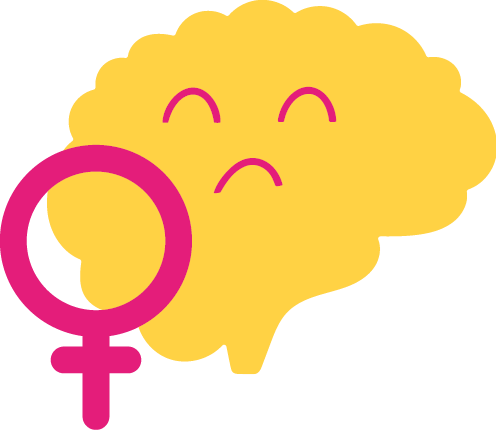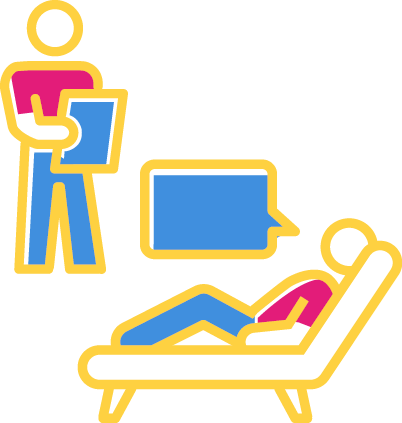Dispelling depression myths: fact-checking and debunking report

Depression, also known as major depressive disorder1, is a common mental health condition2. According to the World Health Organization (WHO), approximately 280 million people globally, or 3.8% of the world’s population, suffer from depression. This includes 5% of adults and 5.7% of adults over the age of 602. Globally, more than 10% of pregnant women or those who have recently given birth experience this condition, and more than 700,000 people die by suicide each year, which ranks as the fourth leading cause of death among young people aged 15 to 292.
Depression can affect social relationships, including those with family and friends, and can impair work life and academic performance2, negatively impacting feelings, thoughts, actions, and one’s perception of the world1. This condition can affect anyone2.
 Depression arises from a complex interplay of social, psychological, and biological factors and can worsen a pre-existing stress condition2. For a diagnosis of depression, symptoms must persist for at least two weeks3. These symptoms can range from mild to severe and vary from person to person. Key symptoms include1:
Depression arises from a complex interplay of social, psychological, and biological factors and can worsen a pre-existing stress condition2. For a diagnosis of depression, symptoms must persist for at least two weeks3. These symptoms can range from mild to severe and vary from person to person. Key symptoms include1:
- Feeling sad, irritable, empty, and/or hopeless
- Experiencing a loss of interest or pleasure in activities previously enjoyed
- Significant changes in appetite (eating much less or more than before) and/or weight (significant weight loss or gain not related to diet)
- Sleeping too much or too little
- Feeling a decrease in physical energy or an increase in fatigue
- Exhibiting purposeless physical activity or being unable to sit still – pacing up and down, wringing hands – or experiencing slowed movement or speech
- Feeling worthless or overly guilty
- Experiencing forgetfulness and/or difficulty concentrating or making decisions, even small ones
- Having thoughts of death, suicidal ideation, or attempting suicide1
There are several types of depressive episodes, including2:
- Single-episode depressive disorder, which remains the individual’s only experience of depression
- Recurrent depressive disorder, characterised by at least two depressive episodes
- Bipolar disorder, where depressive episodes alternate with manic symptoms, such as euphoria or irritability, increased activity, talkativeness, racing thoughts, elevated self-esteem, decreased need for sleep, distractibility, impulsiveness, and reckless behaviour2
Effective treatments for depression are available, including psychological and pharmacological2 treatments or brain stimulation3. If symptoms of depression appear, it is crucial to seek help, but also to try to resume activities that were once enjoyable, maintain contact with friends and family, engage in regular physical activity- even a short walk - adhere to regular eating and sleeping habits as much as possible, and talk to someone trusted, seeking assistance from a healthcare professional2.
References
Shedding light on misconceptions circulating on the web
The social stigma associated with mental disorders and depression is one of the barriers identified by the WHO to efficient care1. Although there are known and effective treatments for mental disorders according to the organization, over 75% of people in low- and middle-income countries receive no treatment1.
In addition to stigma, challenges in accessing adequate care also include a lack of investment in mental health care and a shortage of qualified health professionals1.
The Investigation
To determine the global topics of interest most frequently searched on Google related to depression, Google Trends was utilised. The analysis focused on the period from 2019 to the present and showed three phases in the global search interest regarding depression: a phase of relative stability until the end of January 2022; a subsequent phase until May 2023, marked by several peaks in search interest; and a third phase indicating a steady decline in attention to depression from June 2023 onward, during which people seems to have shifted their searches from “depression” to “anxiety” and “stress”, which are instead on a steadily rising trend. Alongside this, research was conducted on FactChecker.it.
Regarding depression, people queries mainly focused on five areas:

- the meaning of the disease;
- symptoms of depression;
- tests to verify the presence of the disease;
- postpartum depression and trauma;
- possible treatment options for depression.
The Choice of “Fact-Checking”
 To identify the most searched facts on the web, the volumes of questions submitted to Google for each major topic were evaluated using data from the last 5 years. The outcome of this research revealed that the prejudice that depression is predominantly a female condition surpasses all others. The myths that depression is a matter of genetics, and that pharmacological treatment is the only effective cure follow similar trends. Less frequent, but consistent, are also the myths that deny the pathological nature of depression or associate it with a trauma [Fig.1].
To identify the most searched facts on the web, the volumes of questions submitted to Google for each major topic were evaluated using data from the last 5 years. The outcome of this research revealed that the prejudice that depression is predominantly a female condition surpasses all others. The myths that depression is a matter of genetics, and that pharmacological treatment is the only effective cure follow similar trends. Less frequent, but consistent, are also the myths that deny the pathological nature of depression or associate it with a trauma [Fig.1].
Topics or queries searched by users over the last 5 years regarding depression.
[Blue colour: Depression and sadness; Red colour: Familiarity for depression; Yellow colour: Women and depression; Green colour: Traumas and depression; Violet colour: Medications for depression]

The topics requiring clarification, which have attracted considerable research interest, include the following:
- DEPRESSION IS FEMALE

Although depression is more common among women due to biological reasons, hormonal changes, and unique social experiences, anyone can feel depressed1. It is estimated that depression affects 4% of men and 6% of women globally2. However, it is important to remember that:
- Certain types of depression may manifest during specific life stages of a woman, corresponding to hormonal changes, such as during pregnancy, the postpartum period, the menstrual cycle, and perimenopause1
- Men are less likely to recognize emotional problems and seek help. As a result, there is a higher risk that symptoms of depression go undiagnosed or are under-treated in this population3.
- Studies show higher rates of depression among members of the LGBTQI+ community3.
- Mental health symptoms may appear as physical problems, such as increased heart rate, headaches, or gastrointestinal issues: men often tend to consult a doctor for these secondary problems rather than for the direct emotional issues3.
References:
- DEPRESSION IS HEREDITARY

A family history of depression is among the risk factors for this mental health issue1. However, it is acknowledged that:
- In addition to genetic factors, biological, environmental, and psychological factors also play a role in the development of depression1.
- Seasonal depression is recognised, with symptoms typically starting in late autumn or early winter and disappearing during the spring and summer1.
- Trauma, stress, and significant negative life changes can contribute to the onset of depression1.
- A study conducted on over one million people, mainly of European origin, identified 178 genetic variants linked to major depressive disorder2.
References:
- National Institute of Mental Health. Depression. Accessed July 2024
- Levey D. F. et al., Bi-ancestral depression GWAS in the Million Veteran Program and meta-analysis in >1.2 million individuals highlight new therapeutic directions. Nature Neuroscience (2021); 24/7):954-963
- THE ONLY TREATMENT FOR DEPRESSION IS PHARMACOLOGICAL

Psychological therapy, which teaches new ways of thinking, handling problems, or relating to others, is the primary treatment for mild depression1. Antidepressants can be combined with this in moderate and severe cases1. Depression can also be treated in severe cases, and the sooner therapy is started, the more effective it is2. Moreover, it’s helpful to know that:
- There are prevention programmes for depression, including those aimed at improving a positive coping model in children and adolescents1.
- Self-care and physical exercise can play a significant role in managing symptoms of depression and promoting overall well-being1.
- There is no one-size-fits-all treatment: finding the right therapy may require trial and error2.
- In cases of treatment-resistant depression, where symptoms do not resolve after trying at least two different antidepressant treatments at an adequate dose and for an appropriate duration, along with psychotherapy, brain stimulation may be an option2.
- Antidepressants should not be used in children and are not the first line of treatment in adolescents1.
References:
- DEPRESSION IS EQUIVALENT TO A FEELING OF SADNESS

Distinguishing between a feeling of sadness and depression is important and can help people seek help when appropriate and find the right treatment they need1. For this reason, it’s useful to know that:
- A depressive episode is different from normal mood fluctuations: it lasts most of the day, nearly every day, for at least two weeks2.
- Feelings of sadness come in waves, often mixed with positive thoughts, whereas in depression, the mood is lowered for most of the two-week period1.
- With sadness, self-esteem is usually maintained, while in depression, feelings of worthlessness and self-loathing are common1.
- Grief and depression can coexist. When grief and depression co-occur, the grief is more severe and lasts longer than grief without depression1.
References:
- DEPRESSION IS LINKED TO A TRAUMATIC EVENT

The death of a loved one, job loss, or the end of a relationship are traumatic experiences that are difficult to bear, and it is normal to develop a sense of grief afterward1. People often say they feel “depressed” in these situations. However, the grief experienced is different from suffering from depression1:
- The process of mourning is natural and unique to each individual and shares some characteristics with depression: both grief and depression can involve intense sadness and withdrawal from usual activities1.
- In grief, thoughts of death may emerge when fantasizing about “joining” the deceased person, while in major depression, there is a desire to end one’s life because one feels worthless, undeserving of living, or unable to cope with depression1.
- Individuals who have gone through traumatic events are more likely to develop depression2.
References:
- DEPRESSION AFFECTS ONLY CERTAIN AGE GROUPS

Although it often manifests in adulthood, depression can occur at any age1.
It is recognised that:
- Depression appears in children and adolescents, though in children it may be expressed more as irritability or anxiety1.
- Many chronic mood disorders in adults start as high levels of anxiety in children1.
- Depression, especially in middle-aged or elderly people, may occur alongside other illnesses such as diabetes, cancer, heart disease, chronic pain, and Parkinson’s disease1. These conditions often worsen in the presence of depression, and individuals with depression and other illnesses tend to have more severe symptoms of both conditions1.
- Sometimes, a physical health issue, like thyroid disease, or the intake of certain medications causes side effects that contribute to depression1.
